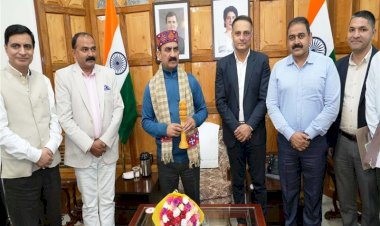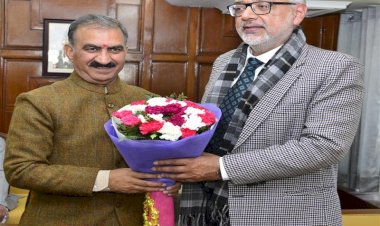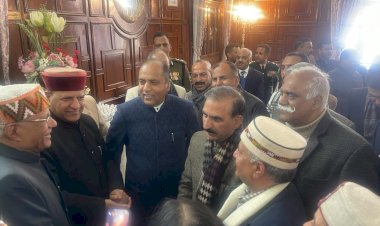We must learn to live with disasters, says CM, Urges preparedness Major SDRF training institute to be established in Palampur: CM
Presides over International Disaster Reduction Day event ‘Samarth-2024'

Chief Minister Thakur Sukhvinder Singh Sukhu said here today that climate change has led to an increase in the frequency of disasters, making it crucial to adapt to living with these challenges. He highlighted that awareness is the key to effectively facing disasters and minimizing the loss of life and property. He stated this while presiding over the International Disaster Reduction Day event, ‘Samarth-2024’.
Sh. Sukhu said that the state government is spending significant amounts of money to raise public awareness about disaster preparedness and has implemented several measures to mitigate the effects of disasters. He said that the state government must remain prepared to tackle future disaster challenges. To this end, a Rs. 800 crore project is being executed in collaboration with the French agency AFD, and Rs. 500 crore is being spent from the mitigation fund. He also announced that a major SDRF training institute will be established in Palampur and that the state is strengthening its infrastructure for better weather forecasting.
The Chief Minister said that the state experienced its first major disaster in the year 1905, when an earthquake in Kangra district claimed over 20,000 lives. He said that the people of the state experienced significant devastation last year during the monsoon season, with over 500 lives lost and damages amounting to Rs 10,000 crore. Despite receiving no assistance from the central government, the state government has successfully rehabilitated 23,000 affected families and implemented a disaster relief package of Rs 4,500 crore. Under this package, compensation for completely destroyed homes has been raised from Rs 1.30 lakh to Rs 7 lakh. Furthermore, the government has amended rules to ensure compensation for families of individuals who went missing during disasters.
Sh. Sukhu criticized political interference in disaster relief efforts, stating, “We have yet to receive the Rs 10,000 crore for the Post-Disaster Needs Assessment (PDNA), although some progress has been made following my intervention. There should be no politics in such matters, and full assistance must be provided to those affected.”
He stated that during the disaster, he remained on the ground for 72 hours, personally overseeing the evacuation of 75,000 tourists and 15,000 vehicles from the state. Within 48 hours, essential services like electricity, water, and communication were temporarily restored, which helped stabilize the situation. The government also ensured minimal disruption for farmers, especially apple growers, allowing their produce to reach markets on time. The state's effective disaster response received praise from the World Bank, NITI Aayog, and former Chief Minister Sh. Shanta Kumar.
The Chief Minister also shared how the government successfully rescued 303 stranded tourists from Chandratal in Lahaul-Spiti district. He said “Revenue Minister Sh. Jagat Singh Negi and Chief Parliamentary Secretary Sh. Sanjay Awasthi, risking their lives, led this challenging mission and ensured the safe return of all tourists.”
He emphasized the importance of maintaining Himachal Pradesh as a clean and green hill state, urging the involvement of all segments of society in this effort. He reiterated the state government’s commitment to transforming Himachal Pradesh into a Green Energy State by March 31, 2026, with a focus on harnessing renewable energy sources.
The chief Minister launched a State Disaster Mitigation Fund portal and introduced an Earthquake Retrofitting Program for Critical Buildings in Himachal Pradesh. This initiative is supported by technical expertise from CBRI Roorkee, NITTTR Chandigarh, and NIT Hamirpur. Additionally, a program titled Rebuilding Live was also launched to develop a Resilient Model Village at Gram Panchayat Bawasni in District Solan, in collaboration with Bal Raksha Bharat and Zee Enterprises Limited.
The Himachal Pradesh State Disaster Management Authority (HPSDMA) also signed an MoU with CBRI Roorkee to enhance the skills of engineers, architects, builders, and masons across the state. As part of this collaboration, a Training and Demonstration Unit (TDU) would be established at Rait in Kangra district, aligning with the goals of the AFD program. The MoU was signed in the presence of Chief Minister Thakur Sukhvinder Singh Sukhu.
During the event, the Chief Minister released two publications, ‘Kavach-1’ and ‘Kavach-2’, authored by scientists from the Central Building Research Institute (CBRI), Roorkee. He also honored children who had won various competitions and presented awards to several individuals for their exceptional work during the Samej, Bagipul, and Rajban cloudburst incidents earlier this monsoon. The awardees included Superintendent of Police (HP SDRF), SDM Rampur, Commandant of the 14th NDRF, Dr. Bhavna Verma (Tehsildar Padhar, Mandi), Deputy Commandant of CISF Jhakri, Mohan Kapatia (Pradhan, GP Sarpara) and Head of Project, SJVN Jhakri.
Dr. Ajay Chourasia, Chief Scientist at the Structural Engineering and Heritage and Special Structures Division of CBRI Roorkee, was also recognized for his expertise. The Chief Minister further awarded Kangra and Chamba districts for being the Best Performing Districts in the state’s “Creation of Task Force of Youth Volunteers for Disaster Preparedness and Response” scheme. Earlier in the day, he inaugurated a disaster awareness exhibition at the Ridge.
MLA Harish Janartha, Mayor Surender Chauhan, Deputy Mayor Uma Kaushal, Additional Chief Secretary (Revenue) Onkar Chand Sharma, ADGP Satwant Atwal, Director of Central Building Research Institute Roorkee Pradeep Kumar, Special Secretary Revenue DC Rana, Deputy Commissioner Anupam Kashyap and SP Sanjeev Gandhi were also present on the occasion.

 hillquest
hillquest 






















